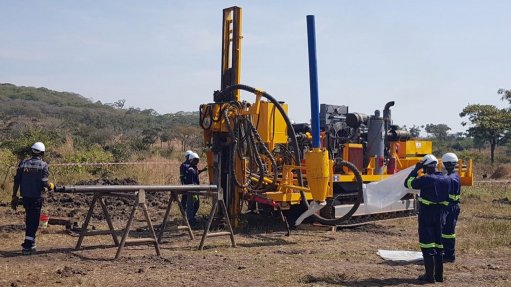
DRILL A-BIT The reverse cirgulation drilling programme has started at Resources Mining Corporation's Liparamba nickel project in Tanzania
A maiden 1 800 m reverse circulation (RC) drilling programme was started by Australian battery metals exploration company Resource Mining Corporation (RMC) in May, at its Liparamba nickel project, situated in the Nyasa Ruvuma region of Tanzania.
The start of the drilling programme, aimed at testing the most prospective targets, comes after the company announced in May the confirmation of at least six nickel sulphide target areas at the project.
RMC has selected drill hole locations to test for nickel sulphide mineralisation within large, significant coincidental geophysical and geochemical anomalies previously identified by multinational mining and metals company BHP Billiton and nickel mining company Albidon.
BHP and Albidon reportedly undertook significant geological groundwork in the region to generate high-quality targets between 2008 and 2013.
The drilling programme involves drilling 12 RC holes at a depth of 150 m and builds on recent audio-frequency magnetotellurics (AMT) and airborne electromagnetics data collection activities.
The results of the new drilling campaign will be combined with historic geological field surveys and previous soil surveys.
By mapping lateral conductivity contrasts, the AMT method has proven effective in identifying prospective areas within specific geological settings for nickel mineralisation and has emerged as a useful tool for nickel exploration.
“The subsequent findings from the AMT geophysical survey at Liparamba have been very encouraging,” says RMC CEO Andrew Nesbitt.
“Not only have they substantiated the significant nickel sulphide targets previously defined by BHP and Albidon, but in addition, they have identified some very promising new targets as well,” he enthuses.
“We look forward to updating investors as we progress,” adds Nesbitt.
Survey Highglights
Nesbitt says the results of the survey demonstrate a strong correlation between the two datasets, with the AMT data providing more granularity with reference to revealing the internal structure of the conductive targets and assessing their internal complexity.
This enhanced level of detail has allowed a more comprehensive understanding of the subsurface geology and the potential mineralisation targets within the Liparamba exploration area.
“Overall, the strong correlation between the versatile time domain electromagnetics conductors and the AMT-modelled two-dimensional sections instills confidence in the data and enables more robust interpretation in three dimensions,” he says.
Additionally, anomalous AMT profiles were consistent across the base of the southern boundary of the mapped mafic inlier at the project.
Other Projects
The Liparamba project forms part of RMC’s Southern Projects portfolio, which include nickel projects at Kitai and Mbinga, which are reported to display ultramafic lithologies over considerable strike lengths with noted nickel anomalism.
RMC’s Kabanga North nickel project, which is located along strike from Kabanga Nickel’s Kabanga project plays host to total mineral resources of 58-million tonnes, grading on average 2.62% nickel.
RMC’s Kapalagula nickel project, which displays copper and platinum-group elements (PGEs), complements the Kabulwanyele nickel project with mapped ultramafic lithologies noted to host copper mineralisation, with nickel and PGEs.
Historical drilling at Kapalagula nickel has identified nickel grades of up to 1.57%.
The Kabulwanyele nickel project has not been subject to any form of modern exploration before such work was conducted by RMC in 2021.
Since then, rock chip and soil samples have demonstrated “excellent” assay results for nickel, manganese and cobalt, according to RMC.
“RMC is well-positioned to advance all its prospects and is committed to working closely with the Tanzanian government and local communities to ensure that its activities have a positive impact on the local economy and environment,” Nesbitt concludes.